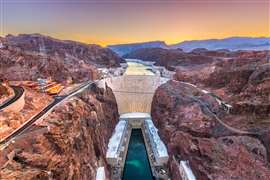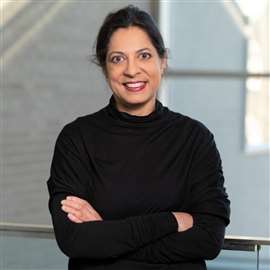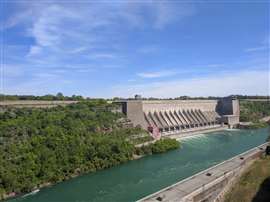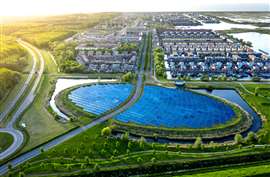Interview: Rethinking the way we build infrastructure
26 March 2024
 The Hoover Dam (Image: SeanPavonePhoto via AdobeStock - stock.adobe.com)
The Hoover Dam (Image: SeanPavonePhoto via AdobeStock - stock.adobe.com)
The way in which societies design and build infrastructure needs to change as the world gets to grips with the challenges that decarbonisation and climate change present.
That’s according to US-based engineering professor Deb Chachra, author of a recently published book called How Infrastructure Works: Transforming Our Shared Systems for a Changing World.
Canadian-born Chachra has been based in the US for the last 20 years and is currently a professor at Olin College of Engineering outside Boston, Massachusetts.
A different perspective
Her fascination with engineering began at an early age. That, combined with an upbringing that involved spending some time at her father’s family home in Bhopal, India, as a child as well as having also lived for a spell in the UK in later life, has given her a different and perhaps unusual perspective on infrastructure.
“Growing up in Canada, where I had full stack power 24/7, very clean water and good transportation was different to spending some time at my parents’ house in India as a child where you had water for an hour in the morning and in the evening, which we boiled before drinking. We expected there would be power brownouts every afternoon in the summer, or else full-on blackouts. There just wasn’t enough electricity to go around,” she says.
“Those kinds of things made infrastructure visible to me, even as a child, in a way that it typically isn’t.”
 Deb Chachra (Image: Leise Jones)
Deb Chachra (Image: Leise Jones)
Her experiences have led Chachra, who has a technical background in engineering physics, materials science and bioengineering to think deeply about infrastructure, its place in society and the shape it will need to take in the future.
That means going beyond the most visible examples that commonly come to mind when people are asked to think about infrastructure – megastructures like the Hoover Dam outside Las Vegas (pictured above), grand bridges and railway stations, or the CN Tower in her home city of Toronto.
In her book, she says, “Collective infrastructures – water and sewage, transportation, electricity, telecommunications – are good candidates for the most complex systems created by humans. They are planetary in scale, build on their own histories, interact with one another and have effects that extend far into the future.
“Their design, construction and operation require a wide range of technical disciplines – civil engineering, obviously, but also electrical engineering, mechanical engineering, environmental engineering, and the science of systems and of networks. All of these fields incorporate not just technologies but practices, ways of thinking, doing and building.”
New ways of thinking
And as climate change advances and efforts to combat it through decarbonisation step up a gear, those ways of thinking have to start to change, she argues.
“Even if you did a good job of building infrastructure and it worked really well for the last 50 years, you can’t keep using the same infrastructure,” she says.
“We notice infrastructure when it fails and, of course, that is happening as the impact of climate change takes hold.”
Recent examples include the collapse of much of Texas’s power and water network in 2021 following a winter storm, which at one point saw 13 million people under a boil-water order. Or 2017’s Hurricane Maria, which devastated the island of Puerto Rico whose ageing power plants and infrastructure were more susceptible to storm damage.
“The reason why we are paying attention to infrastructure again is because we are trying to figure out two things: how to decarbonise it and also how to make it resilient in the face of climate change,” Chachra says. “You can describe it as like having a bathtub that is overflowing – you can mop up the floor all you want but you really need to turn the tap off as well.”
Given that the approach to infrastructure needs to change, Chachra argues that it makes sense to take other considerations into account at the same time – and in particular addressing inequalities that can end up baked into infrastructural systems.
“I had always thought of infrastructure as an unalloyed good,” she says. But in recent decades, there has been a reassessment of whether that has always been the case, prompting people to question who benefits from infrastructure – and who doesn’t.”
“I have always been in the group that was building the systems and benefitting from the systems. I have never been in the group that has been used either to extract resources and bring it to the people who are using it, or otherwise did not have access to these systems,” she adds.
For example, in the case of India, the purpose behind infrastructure constructed under British rule in the 18th and 19th centuries such as ports, railways and telegraphs, was to extract resources for the benefit of the United Kingdom, she points out.
 Robert Moses Niagara Hydroelectric Power Station shot from Canada. (Image: Elena Berd via AdobeStock - stock.adobe.com)
Robert Moses Niagara Hydroelectric Power Station shot from Canada. (Image: Elena Berd via AdobeStock - stock.adobe.com)
In North America, the distribution of benefits and of harms has perhaps been more subtle and she uses the example of the Niagara Falls Power Project, launched in 1961. The power station, 4.5 miles downstream from Niagara Falls, was overseen by New York urban planner Robert Moses. The land on which the plant was built was on the Tuscarora Indian Reservation. The Tuscarora people opposed the project in a dispute that went all the way to the Supreme Court before it ruled in favour of the power authority, authorising it to seize 550 acres of the Tuscarora Reservation.
“Robert Moses rebuilt the hydro power station to make sure that New York had reliable, adequate power in the ‘60s. The people living on the Reservation may be benefiting from the fact that they have this electricity, generated nearby, but they are disproportionately bearing the harms of the project. And we see this pattern over and over again,” she says.
“I’m a brown, female, immigrant engineer. In all of these megaprojects, I promise you there was no-one who looked like me in the room. And now, especially in the US, it’s very clear that we are living in the consequences of those kind of decisions.”
She adds, “All of these things go hand in hand: Making infrastructure sustainable, making it resilient, making it more equitable, and making it functional. We can’t really distinguish between those four anymore.”
Building on a smaller scale
That has led her to advocate for a move, where possible, away from giant, centralised infrastructure projects like the Hoover Dam or major nuclear power stations, to solutions that are appropriate for the communities in which they are embedded.
“We are at the beginning of a technological transformation. Planning to build things that are smaller scale, reversible, exploratory and locally-appropriate seems like the pathway to moving forward,” she argues.
“To me, that’s the big pattern for the next 50 years of infrastructure building. Thanks to significant investment in things like wind and solar over the last 20 years, these kinds of things are possible in a way that they weren’t under fossil fuels.”
She gives the example of community solar energy projects that are both renewable and offer resilience because they aren’t reliant on the centralised provision of power.
 Aerial shot of a modern sustainable neighbourhood in Almere, The Netherlands (Image: Pavlo Glazkov via AdobeStock - stock.adobe.com)
Aerial shot of a modern sustainable neighbourhood in Almere, The Netherlands (Image: Pavlo Glazkov via AdobeStock - stock.adobe.com)
“There’s a group here in Massachusetts called heet.org that is working with our local natural gas provider Eversource, on building a community geothermal project. It is hard and inefficient to build a geothermal heat pump for just one house. It’s easier to build at neighbourhood level and the gas company has the provision to help to do that.”
“Renewables lend themselves to decentralisation and there is a whole new set of possibilities there that I think need to be explored,” she says.
Meanwhile, she is a strong believer in public investment in infrastructure. “I’m a proponent of significant investment in infrastructure, in the sense that it basically gives you at least the potential for accountability and equality that private infrastructure doesn’t do,” she says.
“The reason why we have public systems – public water, electricity, transportation – is because these systems were originally private and it turns out that when you have network monopolies, you can charge the people who have access to your systems whatever you want.”
Summing up the value of infrastructure and the key role it has to play, Chachra says in her book, “As infrastructural networks become more widespread and reliable, we begin to build other systems on top of them; this provides a powerful incentive to make them even more widespread, reliable and enduring.”
“Around the world they have been the roots and the fruits of sustained economic and political cooperation: enabling groups to use and steward resources that are held in common for collective benefit, and to make decisions that are in the best interests of the community. Shared systems are used to meet basic needs, to provide services, to foster social connections and to provide access to physical goods. Infrastructural systems are how we take care of each other and plan for a future of long-term investment and cooperation.”
Chachra’s book, How Infrastructure Works, is published by Torva.
|
STAY CONNECTED



Receive the information you need when you need it through our world-leading magazines, newsletters and daily briefings.
CONNECT WITH THE TEAM









